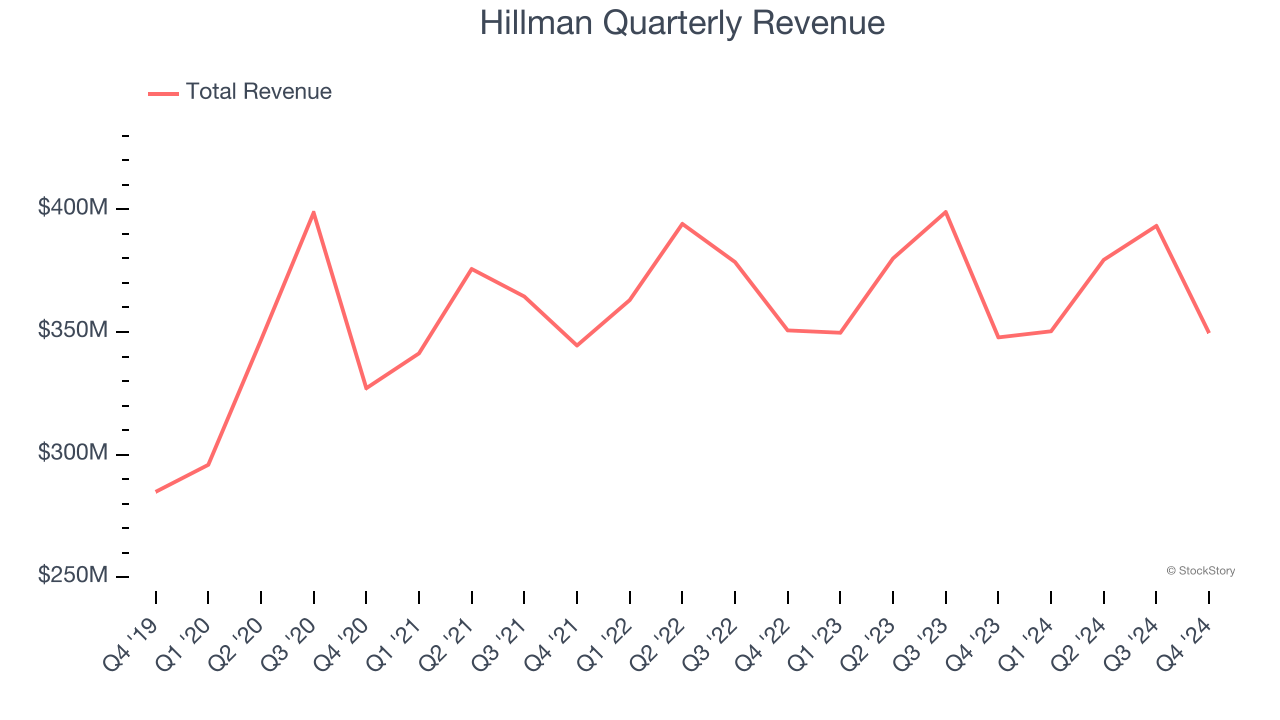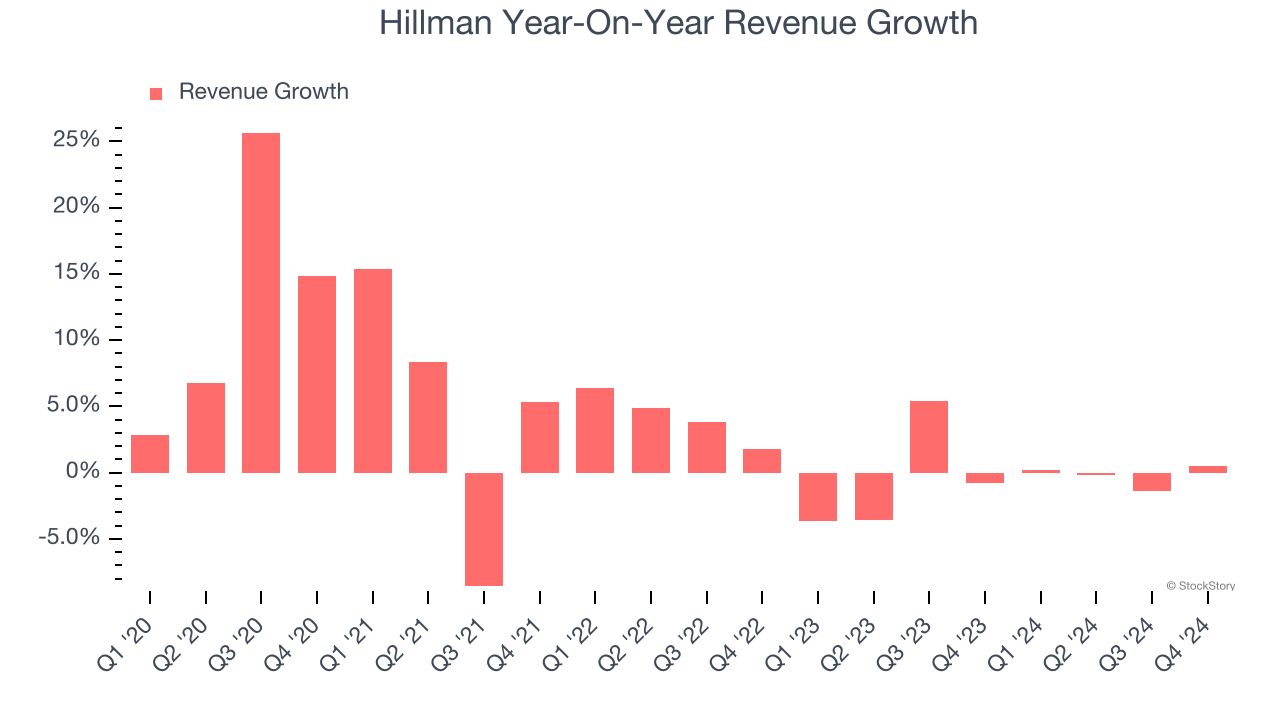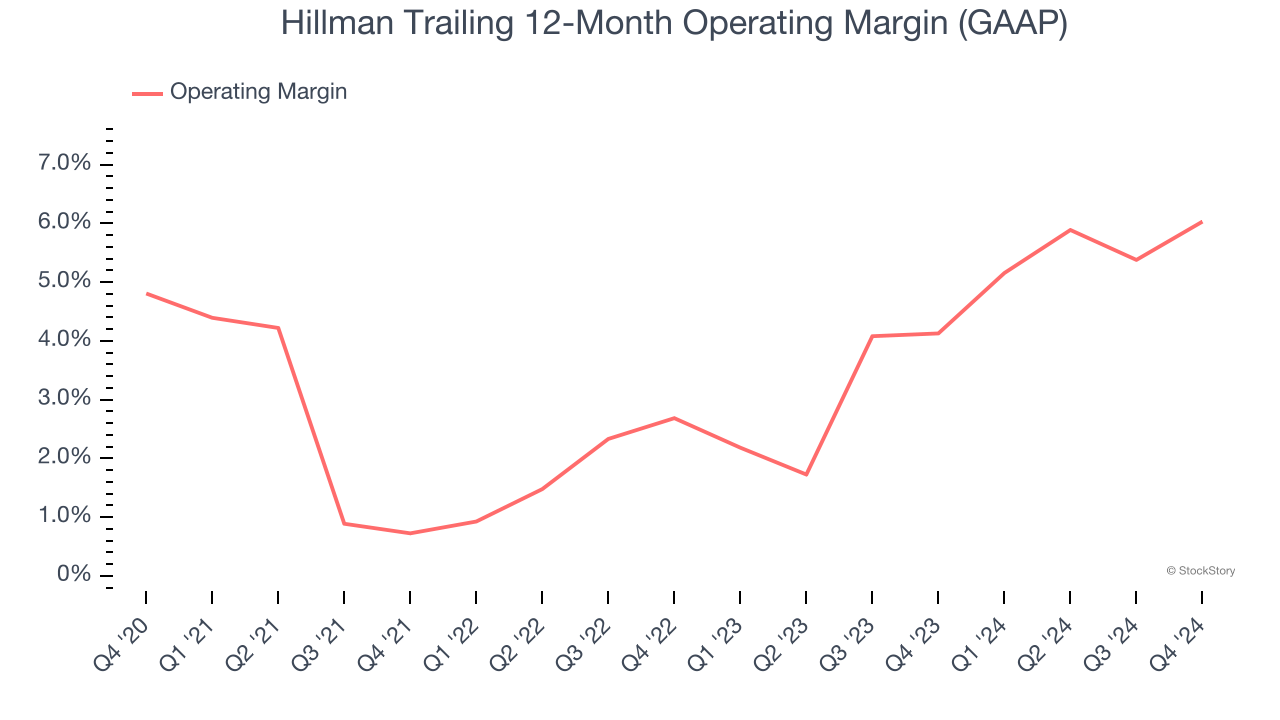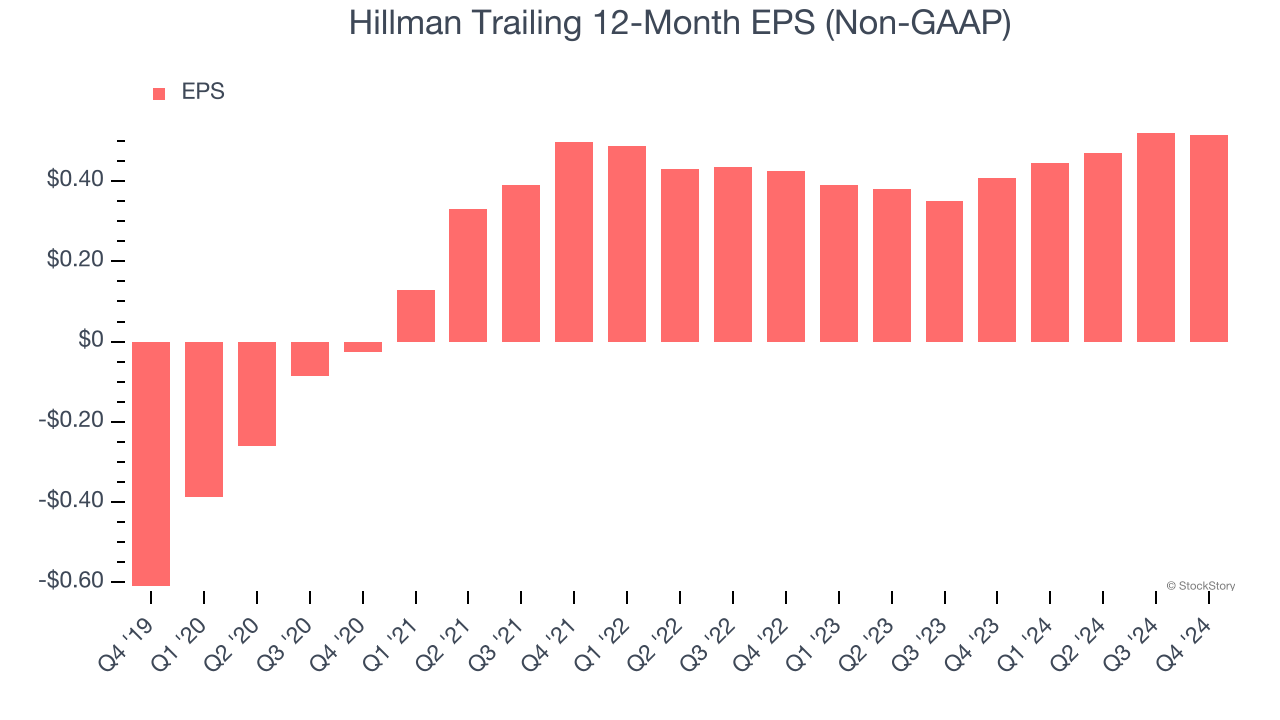
Hardware products and merchandising solutions provider Hillman (NASDAQ:HLMN) missed Wall Street’s revenue expectations in Q4 CY2024, with sales flat year on year at $349.6 million. On the other hand, the company’s outlook for the full year was close to analysts’ estimates with revenue guided to $1.54 billion at the midpoint. Its non-GAAP profit of $0.10 per share was in line with analysts’ consensus estimates.
Is now the time to buy Hillman? Find out by accessing our full research report, it’s free.
Hillman (HLMN) Q4 CY2024 Highlights:
- Revenue: $349.6 million vs analyst estimates of $351.8 million (flat year on year, 0.6% miss)
- Adjusted EPS: $0.10 vs analyst estimates of $0.11 (in line)
- Adjusted EBITDA: $56.27 million vs analyst estimates of $56.47 million (16.1% margin, in line)
- Management’s revenue guidance for the upcoming financial year 2025 is $1.54 billion at the midpoint, in line with analyst expectations and implying 4.2% growth (vs -0.2% in FY2024)
- EBITDA guidance for the upcoming financial year 2025 is $265 million at the midpoint, in line with analyst expectations
- Operating Margin: 4%, up from 1.2% in the same quarter last year
- Free Cash Flow Margin: 6.3%, down from 15.2% in the same quarter last year
- Market Capitalization: $1.98 billion
Doug Cahill, Hillman's executive chairman commented: “During 2024, Hillman delivered record bottom line results despite the soft macro environment. Our focus on disciplined execution and taking care of our customers added to Hillman's 60-year legacy of service, which resulted in us winning vendor of the year awards at our two biggest customers: Home Depot and Lowe's."
Company Overview
Established when Max Hillman purchased a franchise operation, Hillman (NASDAQ:HLMN) designs, manufactures, and sells industrial equipment and systems for various sectors.
Professional Tools and Equipment
Automation that increases efficiency and connected equipment that collects analyzable data have been trending, creating new demand. Some professional tools and equipment companies also provide software to accompany measurement or automated machinery, adding a stream of recurring revenues to their businesses. On the other hand, professional tools and equipment companies are at the whim of economic cycles. Consumer spending and interest rates, for example, can greatly impact the industrial production that drives demand for these companies’ offerings.
Sales Growth
A company’s long-term sales performance signals its overall quality. Even a bad business can shine for one or two quarters, but a top-tier one grows for years. Over the last five years, Hillman grew its sales at a sluggish 3.9% compounded annual growth rate. This was below our standard for the industrials sector and is a rough starting point for our analysis.

We at StockStory place the most emphasis on long-term growth, but within industrials, a half-decade historical view may miss cycles, industry trends, or a company capitalizing on catalysts such as a new contract win or a successful product line. Hillman’s recent history shows its demand slowed as its revenue was flat over the last two years. 
This quarter, Hillman’s $349.6 million of revenue was flat year on year, falling short of Wall Street’s estimates.
Looking ahead, sell-side analysts expect revenue to grow 5.3% over the next 12 months. While this projection indicates its newer products and services will fuel better top-line performance, it is still below average for the sector.
Today’s young investors won’t have read the timeless lessons in Gorilla Game: Picking Winners In High Technology because it was written more than 20 years ago when Microsoft and Apple were first establishing their supremacy. But if we apply the same principles, then enterprise software stocks leveraging their own generative AI capabilities may well be the Gorillas of the future. So, in that spirit, we are excited to present our Special Free Report on a profitable, fast-growing enterprise software stock that is already riding the automation wave and looking to catch the generative AI next.
Operating Margin
Operating margin is an important measure of profitability as it shows the portion of revenue left after accounting for all core expenses – everything from the cost of goods sold to advertising and wages. It’s also useful for comparing profitability across companies with different levels of debt and tax rates because it excludes interest and taxes.
Hillman was profitable over the last five years but held back by its large cost base. Its average operating margin of 3.7% was weak for an industrials business. This result is surprising given its high gross margin as a starting point.
On the plus side, Hillman’s operating margin rose by 1.2 percentage points over the last five years.

In Q4, Hillman generated an operating profit margin of 4%, up 2.8 percentage points year on year. The increase was encouraging, and since its operating margin rose more than its gross margin, we can infer it was recently more efficient with expenses such as marketing, R&D, and administrative overhead.
Earnings Per Share
Revenue trends explain a company’s historical growth, but the long-term change in earnings per share (EPS) points to the profitability of that growth – for example, a company could inflate its sales through excessive spending on advertising and promotions.
Hillman’s full-year EPS flipped from negative to positive over the last five years. This is encouraging and shows it’s at a critical moment in its life.

Like with revenue, we analyze EPS over a shorter period to see if we are missing a change in the business.
Hillman’s EPS grew at a solid 10.2% compounded annual growth rate over the last two years, higher than its flat revenue. This tells us management responded to softer demand by adapting its cost structure.
Diving into the nuances of Hillman’s earnings can give us a better understanding of its performance. Hillman’s operating margin has expanded by 2.9 percentage points over the last two years. This was the most relevant factor (aside from the revenue impact) behind its higher earnings; taxes and interest expenses can also affect EPS but don’t tell us as much about a company’s fundamentals.
In Q4, Hillman reported EPS at $0.10, in line with the same quarter last year. This print missed analysts’ estimates, but we care more about long-term EPS growth than short-term movements. Over the next 12 months, Wall Street expects Hillman’s full-year EPS of $0.52 to grow 8.6%.
Key Takeaways from Hillman’s Q4 Results
The quarter was relatively in line, with revenue missing very slightly but both EBITDA and EPS meeting expectations. Looking ahead, Hillman also provide full-year revenue and EBITDA guidance that hovered around analysts’ expectations. Overall, this was a fine quarter with few surprises. The stock traded up 1.2% to $10.50 immediately following the results.
So do we think Hillman is an attractive buy at the current price? We think that the latest quarter is only one piece of the longer-term business quality puzzle. Quality, when combined with valuation, can help determine if the stock is a buy. We cover that in our actionable full research report which you can read here, it’s free.

